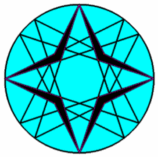QA-Ci1: QA-Circumcircle Diagonal Triangle
The diagonal circle is the circumcircle of the Diagonal Triangle (DT) of a Quadrangle.
The Diagonal Triangle of a Quadrangle is the triangle formed by the intersection points of the 3 distinctive pairs of lines of a Quadrangle.

Equation CT-notation:
a2 q r (p+q) (r+p) (+q r x2 – p r y2 – p q z2 – r (p–q) x y + p (q+r) y z + q (r–p) z x)
+ b2 p r (p+q) (q+r) (–q r x2 + p r y2 – p q z2 + r (p–q) x y – p (q–r) y z + q (r+p) z x)
+ c2 p q (r+p) (q+r) (–q r x2 – p r y2 + p q z2 + r (p+q) x y + p (q–r) y z – q (r–p) z x) = 0
Equation DT-notation:
a2 y z + b2 x z + c2 x y = 0
Properties
- QA-P11 is the center of the QA-Ci1.
- QA-P2 (Euler-Poncelet Point) and QA-P30 (Reflection of QA-P2 in QA-P11) lie on QA-Ci1.
- QA-Ci1 is the Involutary Conjugate (see QA-Tf2) of QA-L9, which is the perpendicular bisector of QA-P2.QA-P4.
- The QA-DT-Conic Perspector (see QA-Co-1) of QA-Ci1 is QA-P38.
- Let O1, O2, O3, O4 be the circumcenters of the Component Triangles of Reference Quadrangle P1.P2.P3.P4. Let OPi be the Orthopole (see [13]) of line QA-P12.Oi wrt Component Triangle Pj.Pk.Pl, where (i,j,k,l) ∈ (1,2,3,4). The 4 Orthopoles OP1, OP2, OP3, OP4 lie on QA-Ci1. See [11] Hyacinthos messages # 21865 & 21867.
- The QL-Tf1 image of QA-Ci1 is the circle through QG-2P2a, QG-2P2b, QG-P19, QA-P4. See [34], Eckart Schmidt, QFG#665.
Estimated human page views: 595
